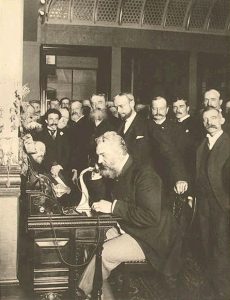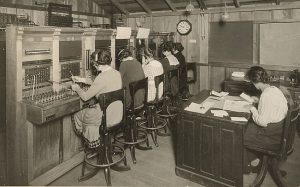Industrial Revolution (1800’s-1940’s)
48 The Invention of the Telephone
Corinne Castelli
Introduction
The Industrial Revolution was an extremely important time in history to note when discussing the improvement of communication. In the early 1800’s, America was becoming familiar with the telegraph, which was an invention dedicated to improving communication. It was the first time somewhat-instant communication over long distances could occur; before this, the printing press was the largest invention used for communication and written communication was the main way individuals could keep in touch without traveling long distances to physically visit one another. However, the telegraph’s technology was not exactly instantaneous, as it would take a few minutes to send a message over a large distance. During the time of the invention of the telegraph, the innovation behind the telephone was already taking place (“History of the Telephone”, 2024).
Connection to STS
The invention of the telephone is a clear example of technology created through scientific observations interacting with society. Men not trusting the telephone initially is an example of society being skeptical of technological innovations, and women not being able to interact with the technology based on what their husband thought of the device makes them a missing voice in society at the time. Inventions like the telephone throughout time have been made from scientific observations in an effort to better society, and how society interacts with the invention and what society uses the invention for allows the invention to evolve over time, which is exactly what the telephone has done from its invention to today.
Who invented the telephone?
As mentioned earlier, innovation of the telephone was already taking place as America was becoming familiar with the telegraph in the early 1800’s. Antonio Meucci is credited with making the first basic phone in 1849, which was during the time of the telegraph’s invention. However, the main person credited for the telephone’s invention is Alexander Graham Bell. He started research in 1874 and was granted the first U.S. patent for the telephone in 1876 (Anderson, 2005). This invention was the first time instant communication was able to occur over long distances. By 1880, almost 50,000 telephones were in use (Anderson, 2005).
Who could use the telephone?
Initially, the telephone was mainly used to link small groups of households and businesses together (Martin, 1991). This thus is exclusive to those that were wealthy enough to get their homes wired up, which made it an unfair advantage for those less fortunate and were unable to afford to install the wires for the telephone in their homes.

Businesses that needed telephones could have them installed, so men were able to use the telephone in their offices. However, for any individual (mostly women) who didn’t have telephones installed in their homes, they could walk to the general store to make and receive phone calls; although this allowed more individuals to use the telephone, those who had to travel to use the invention had to plan well in advance for this. (Anderson, 2005) Although privacy within telephone calls is a concern and priority today, at the time of its invention, a telephone without a public aspect was not very useful, (Sterling, 2004) so not having privacy was not an issue initially.
The social impact of the telephone
Like mentioned earlier, the telephone’s initial impact mainly affected those who were in wealthy businesses that required communication from distant locations (Martin, 1991). So, men of power mainly interacted with the telephone, and were hesitant to bring it into their homes as it was a new technology. It is noted that during its invention, men (who controlled society at the time) did not see the need for women to interact with the technology. It is written that the main consensus on women’s use of the telephone was that “women’s use of men’s technology would come to no good end” (Moyal, 1989). Only when telephone usage expanded to residential areas did the invention impact more than just those who were wealthy enough to install it in their homes or interacted with it through office work and business ordeals.
Could women use the telephone?
As mentioned before, women who did not already have the telephone installed in their homes had to travel to a public place where one was installed to communicate. However, if a telephone was installed in a woman’s home was not up to her; women’s interactions with the telephone based on if their husbands trusted the technology or not (Sterling, 2004).

If a telephone was installed in a house, it was more than likely because the man of the house needed it for work purposes, to be able to “link the businessman to his to his office when he chose to stay at home” (Moyal, 1989). When the telephone did reach more residential areas and became more widely used by more groups of people did women get the opportunity to interact with the telephone more. Women’s initial use of the telephone was for friendship purposes it is noted; if they worked a job that allowed them to interact with the technology were they able to use it earlier in time.
Conclusion
Overall, the telephone has drastically changed communication in the world and has evolved incredibly over time, being a technology that everyone today is familiar with and knows how to use. Through continuous changes in the telephone to adapt to modern-technology, communication has evolved completely with time. The telephone has evolved today to become completely portable, and “phone calls” can even occur over smart devices and laptops/computers. Unlike at the time of its invention, today, any person of any background has easy access to a phone whether it be a landline or a smartphone, and is able to communicate with whoever they wish, wherever they are in the world (Moyal, 1989).
References
Glew, H. (2020). Maiden, Whom We Never See.
Moyal, A. (1989). The Feminine Culture of the Telephone.
Prometheus. Vol. 7 (1st ed., pp. 5-31).
https://doi.org/10.1080/08109028908629038
Sterling, C. H. (2004). CBQ REVIEW ESSAY. Booknotes Quarterly, Vol. 35 (4th ed., pp. 222-241). https://www.tandfonline.com/doi/abs/10.1207/s15326896cbq3504_1
Martin, M. (1991). Sex/Machine: Readings in Culture, Gender, and Technology.
Anderson, J. A. (2005). 1870s-1940s: Telephone.
History of the telephone and communication with businesses. (2024). Mitel.
https://www.mitel.com/articles/history-telephone-and-communication-businesses
Image citations
“Alexander Graham Telephone in Newyork.” (2015). Wikipedia Commons. [Digital Image]. https://commons.wikimedia.org/wiki/File:Alexander_Graham_Telephone_in_Newyork.jpg
“Signal Corps – Apparatus – Telephone Operators – Women 165-WW-511C-002.” (2023). Wikipedia Commons. [Digital Image]. https://commons.wikimedia.org/wiki/File:Signal_Corps_-_Apparatus_-_Telephone_Operators_-_Women_165-WW-511C-002.jpg
AI Acknowledgement
AI was not used for the planning, creation, or completion of this project.

